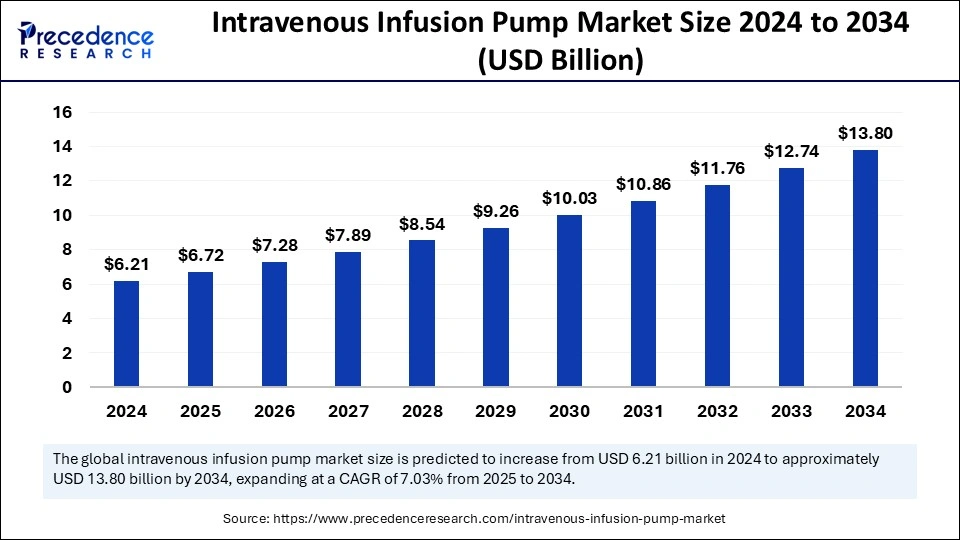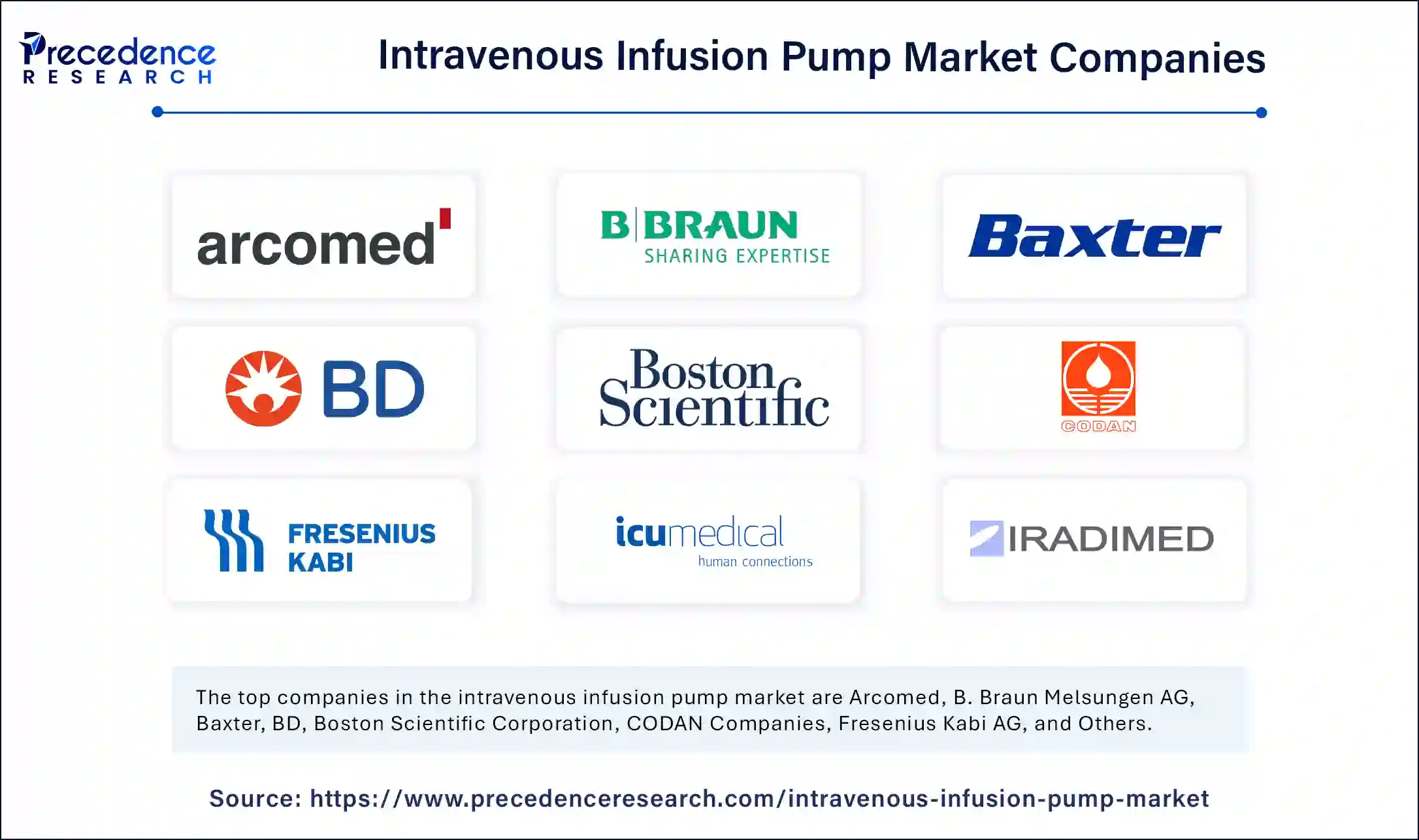The global intravenous infusion pump market size is projected to hit around USD 13.80 billion by 2034 increasing from USD 6.21 billion in 2024, with a CAGR of 7.03%.

Get a Free Sample Copy of the Report@ https://www.precedenceresearch.com/sample/5820
Intravenous Infusion Pump Market Key Points
-
North America dominated the global market in 2024, securing 50% of the total market share.
-
Asia Pacific is expected to have the highest growth rate, with a CAGR of 8.84% from 2025 to 2034.
-
Europe has been increasingly gaining market share in recent times.
-
The volumetric infusion pump segment held the largest share of 19% in 2024.
-
The ambulatory infusion pump segment is projected to grow significantly in the years ahead.
-
By disease indication, the pediatrics/neonatology segment captured the largest market share of 27% in 2024.
-
The chemotherapy segment is expected to experience a notable expansion in the forecasted period.
-
The hospitals segment held the largest share in 2024 by end-use.
-
Homecare settings are set to expand rapidly between 2025 and 2034.
Transforming Patient Care: The Impact of AI on the IV Infusion Pump Market
AI is transforming the Intravenous (IV) Infusion Pump Market by significantly improving safety, efficiency, and personalization in patient care. AI-powered pumps can detect anomalies in infusion rates, adjust settings automatically based on real-time patient data, and predict potential issues like blockages, reducing human error and enhancing patient safety.
These smart systems streamline workflows by automating tasks such as programming infusion rates and enabling remote monitoring, making it easier for healthcare providers to manage multiple patients efficiently, especially in telemedicine and homecare settings. Additionally, AI’s ability to optimize infusion protocols based on individual patient data allows for more personalized treatment and better outcomes.
Moreover, AI contributes to predictive maintenance, helping healthcare facilities avoid downtime by predicting when pumps need servicing. While AI-driven infusion pumps may have higher initial costs, they ultimately lead to cost savings by reducing errors, minimizing manual intervention, and improving patient outcomes.
AI also helps healthcare providers comply with regulatory standards by automating documentation and providing valuable data insights. As AI technology continues to evolve, its role in the IV infusion pump market is expected to grow, driving further advancements in smart healthcare systems and leading to more autonomous, efficient, and cost-effective patient care.
Intravenous Infusion Pump Market Growth Factors
1. Rising Prevalence of Chronic Diseases
The growing prevalence of chronic diseases such as cancer, diabetes, cardiovascular disorders, and kidney diseases is a significant driver for the IV infusion pump market. These conditions often require regular administration of intravenous medications, fluids, or nutrition, increasing the demand for efficient, accurate, and reliable infusion pumps.
2. Aging Population
The global aging population is another crucial factor contributing to market growth. As people age, they are more prone to conditions that require continuous intravenous therapy. Older patients often require complex infusion treatments, and this demographic trend is fueling the demand for infusion pumps in hospitals and homecare settings.
3. Technological Advancements
Continuous innovations in IV infusion pump technology, such as the integration of AI, smart sensors, and wireless connectivity, are driving market growth. These advancements improve the functionality, safety, and ease of use of infusion pumps, making them more attractive to healthcare providers. AI-driven pumps that optimize infusion rates based on real-time patient data are becoming increasingly popular.
4. Increasing Surgical Procedures
As the number of surgical procedures worldwide rises, the need for accurate and controlled drug delivery systems is also growing. Infusion pumps are integral during and after surgeries for pain management, anesthesia administration, and fluid balance, boosting their demand in operating rooms and recovery units.
5. Homecare and Ambulatory Infusion Therapies
The growing trend toward homecare and ambulatory infusion therapies is another factor driving market growth. Patients receiving treatments like chemotherapy, parenteral nutrition, and pain management at home require portable and user-friendly infusion pumps. The demand for homecare infusion pumps is increasing due to the convenience, reduced hospital visits, and lower healthcare costs associated with home treatment.
6. Focus on Patient Safety
The increasing emphasis on patient safety in healthcare environments is driving the demand for infusion pumps. Smart infusion pumps with features such as dose error reduction, alarms, and precise flow control are in high demand, as they help minimize the risk of medication errors and adverse events.
7. Growing Healthcare Infrastructure in Emerging Markets
Emerging economies, particularly in Asia Pacific and Latin America, are investing heavily in healthcare infrastructure. As healthcare systems in these regions improve and expand, there is an increasing need for advanced medical equipment like IV infusion pumps to meet the growing demand for intravenous therapies in hospitals, clinics, and outpatient settings.
8. Regulatory Support and Reimbursement Policies
Governments and regulatory bodies are increasingly implementing supportive reimbursement policies and regulations that facilitate the adoption of advanced medical technologies, including infusion pumps. This is especially evident in developed markets where insurance coverage for infusion pump therapies is improving, encouraging the widespread use of these devices.
9. Rising Demand for Precision Medicine
The trend toward precision medicine, where treatment is tailored based on individual patient needs, is pushing the demand for advanced infusion pumps that can deliver customized drug dosages and therapies with high accuracy. This is especially relevant in oncology, pediatrics, and pain management, where precise medication administration is critical.
10. Increased Awareness of Infusion Pump Benefits
Growing awareness among healthcare professionals and patients about the benefits of infusion pumps—such as their ability to provide controlled and consistent medication delivery—has further fueled the adoption of these devices. Educational campaigns and training programs have also contributed to a better understanding of infusion pump technology in both clinical and homecare settings.
Intravenous Infusion Pump Market Scope
| Report Coverage | Details |
| Market Size by 2034 | USD 13.80 Billion |
| Market Size in 2025 | USD 6.72 Billion |
| Market Size in 2024 | USD 6.21 Billion |
| Market Growth Rate from 2025 to 2034 | CAGR of 7.03% |
| Dominating Region | North America |
| Fastest Growing Region | Asia Pacific |
| Base Year | 2024 |
| Forecast Period | 2025 to 2034 |
| Segments Covered | Product Type, Disease Indication and Regions. |
| Regions Covered | North America, Europe, Asia-Pacific, Latin America, and Middle East & Africa |
Market Dynamics
Drivers
Several factors are driving the growth of the IV infusion pump market. The rising incidence of chronic diseases like diabetes, cardiovascular diseases, and cancer, along with the aging population, is increasing the demand for consistent and controlled medication delivery.
Additionally, advancements in infusion pump technology, such as smart pumps with real-time monitoring and AI integration, are enhancing the market’s growth. The trend of personalized medicine and the increasing number of surgeries and outpatient treatments also contribute to market expansion.
Opportunities
The market presents significant opportunities due to the increasing focus on homecare and ambulatory care settings. With more patients receiving treatments at home, portable and easy-to-use infusion pumps are in high demand. Moreover, emerging markets like Asia Pacific are rapidly adopting advanced healthcare technologies, offering vast growth potential.
Technological innovations, such as wireless connectivity, predictive maintenance features, and improved patient safety mechanisms, provide further opportunities for market growth.
Challenges
Despite the promising growth, the intravenous infusion pump market faces several challenges. High initial costs of advanced infusion pumps can be a barrier, particularly for healthcare facilities in developing regions. Additionally, issues related to product recalls, safety concerns, and regulatory compliance can hinder market progress.
The complexity of technology integration and the need for continuous maintenance and training for healthcare staff are other challenges that could limit the adoption of new systems.
Regional Insights
North America is currently the largest market for intravenous infusion pumps, driven by advanced healthcare infrastructure, a high prevalence of chronic diseases, and significant healthcare investments. Europe follows closely, with countries like Germany and the UK leading the demand due to technological advancements and a growing elderly population.
The Asia Pacific region is projected to grow at the fastest rate, driven by the rising healthcare spending, increasing patient pool, and expanding healthcare infrastructure in countries like China and India.
Intravenous Infusion Pump Market Companies

- Arcomed
- B. Braun Melsungen AG
- Baxter
- BD
- Boston Scientific Corporation
- CODAN Companies
- Fresenius Kabi AG
- ICU Medical, Inc. (Smiths Medical)
- IRadimed Corporation
- Micrel Medical Devices SA
- Moog Inc.
- Shenzhen Mindray Bio-Medical Electronics Co., Ltd.
- Terumo Corporation
Leaders Announcements
- On November 12, 2024, ICU Medical and Otsuka Pharmaceutical Factory announced a joint venture to enhance IV solutions manufacturing and innovation in North America, strengthening supply chain resilience and advancing medical device development.
- In January 2024, Lemer Pax, a global radiation protection leader, partnered with ICU Medical to distribute the Plum 360 infusion pump in France’s nuclear medicine sector, aiming to expand sales across the European market.
Intravenous Infusion Pump Market Recent Developments
- On January 31, 2025, UCB announced that the CHMP had issued a positive opinion for two new administration methods of RYSTIGGO® (rozanolixizumab) for generalized myasthenia gravis (gMG) in the EU. Patients can now self-administer the treatment via an infusion (syringe pump) or a manual push syringe after training from a healthcare professional.
Segments Covered in the Report
By Product Type
- Volumetric Infusion Pumps
- Insulin Infusion Pumps
- Syringe Infusion Pumps
- Enteral Infusion Pumps
- Ambulatory Infusion Pumps
- Patient Controlled Analgesia (PCA)
- Implantable Infusion Pumps
- Others
By Disease Indication
- Chemotherapy
- Diabetes
- Gastroenterology
- Analgesia/Pain Management
- Pediatrics/Neonatology
- Hematology
- Others
By Geography
- North America
- Europe
- Asia-Pacific
- Latin America
- Middle East and Africa
Also Read: Surgical Sponge Market
Ready for more? Dive into the full experience on our website@ https://www.precedenceresearch.com/